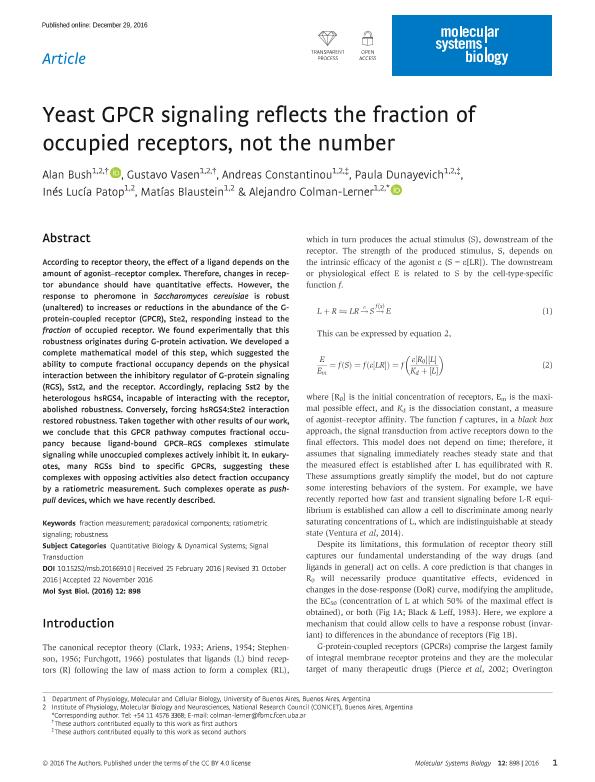Artículo
Yeast GPCR signaling reflects the fraction of occupied receptors, not the number
Bush, Alan ; Vasen, Gustavo
; Vasen, Gustavo ; Constantinou, Andreas; Dunayevich, Paula; Inés Patop; Matías Blaustein; Colman Lerner, Alejandro Ariel
; Constantinou, Andreas; Dunayevich, Paula; Inés Patop; Matías Blaustein; Colman Lerner, Alejandro Ariel
 ; Vasen, Gustavo
; Vasen, Gustavo ; Constantinou, Andreas; Dunayevich, Paula; Inés Patop; Matías Blaustein; Colman Lerner, Alejandro Ariel
; Constantinou, Andreas; Dunayevich, Paula; Inés Patop; Matías Blaustein; Colman Lerner, Alejandro Ariel
Fecha de publicación:
12/2016
Editorial:
Nature Publishing Group
Revista:
Molecular Systems Biology
ISSN:
1744-4292
Idioma:
Inglés
Tipo de recurso:
Artículo publicado
Clasificación temática:
Resumen
According to receptor theory, the effect of a ligand depends on the amount of agonist–receptor complex. Therefore, changes in receptor abundance should have quantitative effects. However, the response to pheromone in Saccharomyces cerevisiae is robust (unaltered) to increases or reductions in the abundance of the G-protein-coupled receptor (GPCR), Ste2, responding instead to the fraction of occupied receptor. We found experimentally that this robustness originates during G-protein activation. We developed a complete mathematical model of this step, which suggested the ability to compute fractional occupancy depends on the physical interaction between the inhibitory regulator of G-protein signaling (RGS), Sst2, and the receptor. Accordingly, replacing Sst2 by the heterologous hsRGS4, incapable of interacting with the receptor, abolished robustness. Conversely, forcing hsRGS4:Ste2 interaction restored robustness. Taken together with other results of our work, we conclude that this GPCR pathway computes fractional occupancy because ligand-bound GPCR–RGS complexes stimulate signaling while unoccupied complexes actively inhibit it. In eukaryotes, many RGSs bind to specific GPCRs, suggesting these complexes with opposing activities also detect fraction occupancy by a ratiometric measurement. Such complexes operate as push-pull devices, which we have recently described.
Archivos asociados
Licencia
Identificadores
Colecciones
Articulos(IFIBA)
Articulos de INST.DE FISICA DE BUENOS AIRES
Articulos de INST.DE FISICA DE BUENOS AIRES
Citación
Bush, Alan; Vasen, Gustavo; Constantinou, Andreas; Dunayevich, Paula; Inés Patop; et al.; Yeast GPCR signaling reflects the fraction of occupied receptors, not the number; Nature Publishing Group; Molecular Systems Biology; 12; 12; 12-2016; 1-20
Compartir
Altmétricas



